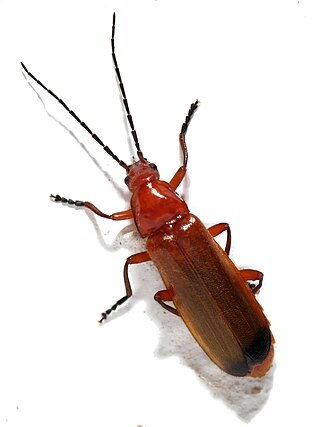
A daylily or day lily is a flowering plant in the genus Hemerocallis, a member of the family Asphodelaceae, subfamily Hemerocallidoideae. Despite the common name, it is not in fact a lily. Gardening enthusiasts and horticulturists have long bred daylily species for their attractive flowers. Thousands of cultivars have been registered by local and international Hemerocallis societies. Daylilies are perennial plants, whose name alludes to its flowers, which typically last about a day.

The Pacific golden plover is a migratory shorebird that breeds during Alaska and Siberia summers. During nonbreeding season, this medium-sized plover migrates widely across the Pacific.

Amanita fulva, commonly called the tawny grisette or the orange-brown ringless amanita, is a basidiomycete mushroom of the genus Amanita. It is found frequently in deciduous and coniferous forests of Europe, and possibly North America.

The cave swallow is a medium-sized, squarish-tailed swallow belonging to the same genus as the more familiar and widespread cliff swallow of North America. The cave swallow, also native to the Americas, nests and roosts primarily in caves and sinkholes.

Hemerocallis fulva, the orange day-lily, tawny daylily, corn lily, tiger daylily, fulvous daylily, ditch lily or Fourth of July lily, is a species of daylily native to Asia. It is very widely grown as an ornamental plant in temperate climates for its showy flowers and ease of cultivation. It is not a true lily in the genus Lilium, but gets its name from the superficial similarity of its flowers to Lilium and from the fact that each flower lasts only one day.

Rhagonycha fulva, the common red soldier beetle, also misleadingly known as the bloodsucker beetle, and popularly known in England as the hogweed bonking beetle is a species of soldier beetle (Cantharidae).
Vernaya is a genus of rodent in the subfamily Murinae from southern China and northern Burma. It contains a single extant species, the red climbing mouse, and several extinct species, all described by Zheng in 1993, namely Vernaya prefulva, Vernaya pristina, Vernaya giganta and Vernaya wushanica. The genus is named after Arthur Stannard Vernay who collected the specimen of V. fulva on an expedition to Burma with Charles Suydam Cutting.
The hybrid elm cultivar Ulmus × hollandica 'Fulva' is one of a number of cultivars arising from the crossing of Wych Elm U. glabra with Field Elm U. minor. Originally raised by Hesse's Nurseries, Weener, Germany, it was first mentioned in Mededeeling, Comite inzake Bestudeering en Bestrijding van de Iepenziekte 10: 9, 1932, but without description. Hesse's 1933 catalogue shows both U. fulvaHort. and U. fulvaMichx..

The American elm cultivar Ulmus americana 'Pendula' was originally listed by William Aiton in Hort. Kew, 1: 320, 1789, as U. americana var. pendula, cloned in England in 1752 by James Gordon. From the 1880s the Späth nursery of Berlin supplied a cultivar at first listed as Ulmus fulva (Michx.) pendulaHort., which in their 1899 catalogue was queried as a possible variety of U. americana, and which thereafter appeared in their early 20th-century catalogues as U. americana pendula. The Scampston Elm, Ulmus × hollandica 'Scampstoniensis', in cultivation on both sides of the Atlantic in the 19th and 20th centuries, was occasionally referred to as 'American Weeping Elm' or Ulmus americana pendula. This cultivar, however, was distinguished by Späth from his Ulmus americana pendula.

The red climbing mouse, also known as Vernay's climbing mouse, is a species of rodent in the family Muridae. It is named after explorer and antiques dealer, Arthur Vernay, who sponsored the expedition during which the animal was first discovered. It is the only living species in the genus Vernaya, and has no subspecies.
Fulvous is a colour, sometimes described as dull orange, brownish-yellow or tawny; it can also be likened to a variation of buff, beige or butterscotch. As an adjective it is used in the names of many species of birds, and occasionally other animals, to describe their appearance. It is also used as in mycology to describe fungi with greater colour specificity, specifically the pigmentation of the surface cuticle, the broken flesh and the spores en masse.

Cephalopholis fulva, the coney or the butterfish, is a species of marine ray-finned fish, a grouper from the subfamily Epinephelinae which is in the family Serranidae which also includes the anthias and sea basses. It is found in the western Atlantic. It is associated with reefs and is a quarry species for commercial and recreational fisheries. It can be found in the aquarium trade.
Corrhenes is a genus of longhorn beetles of the subfamily Lamiinae, containing the following species:
Corrhenes crassicollis is a species of beetle in the family Cerambycidae. It was described by Francis Polkinghorne Pascoe in 1864. It is known from Australia. It contains the varietas Corrhenes crassicollis var. picta.
Corrhenes sectator is a species of beetle in the family Cerambycidae. It was described by Francis Polkinghorne Pascoe in 1865. It is known from Australia.
Corrhenes scenica is a species of beetle in the family Cerambycidae. It was described by Francis Polkinghorne Pascoe in 1863.
Corrhenes funebris is a species of beetle in the family Cerambycidae. It was described by Stephan von Breuning in 1938.
Corrhenes glauerti is a species of beetle in the family Cerambycidae. It was described by McKeown in 1942. It is known from Australia.
Corrhenes paulla is a species of beetle in the family Cerambycidae. It was first described by Ernst Friedrich Germar in 1848 as Saperda paulla. It is known from Australia. The Australian Faunal Directory gives the accepted name for this species as Rhytiphora paulla.
Corrhenes mastersi is a species of beetle in the family Cerambycidae. It was described by Blackburn in 1897.








